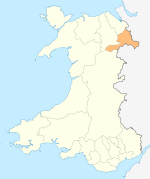- Maelor
-
Coordinates: 53°03′50″N 2°52′19″W / 53.064°N 2.872°W Maelor is a border area of north-east Wales. It originated as a Cantref of the Kingdom of Powys, focused on Bangor-on-Dee.
Contents
History
The Maelor was first divided from the rest of Wales by the construction of Offa's Dyke in the eighth century, but was reclaimed for Wales during the reign of Stephen of England (1135-54) by Madog ap Maredudd of Powys. He died in 1160 and the region was subdivided amongst his heirs and the heirs of Tudor Trevor. By the thirteenth century Maelor had been divided into numerous parts. There was Maelor Gymraeg based upon Wrexham and various Anglo-Norman lordships, namely Overton, Ellesmere, Whittington and Oswestry.
In 1282-1283, Edward I of England completed the conquest of the area east of the River Dee, the various lordships being known as the Maelor Saesneg. The western area remained Welsh as the Maelor Gymraeg. These names existed by 1202.
Maelor Saesneg
In 1397, under Richard II of England, the Maelor Saesneg was merged with the County Palatine of Chester to form the Principality of Chester.
The Maelor Saesneg, the "English-speaking Maelor" is an area of Wales along the eastern border. In 1536 the area was included in the newly-created county of Flintshire, forming the Hundred of Maelor. Although part of Flintshire, Maelor Hundred was an exclave, surrounded by Cheshire, Shropshire and Denbighshire. The administrative centre of the area, often referred to as Flintshire Detached, was Overton and it included the villages of Bangor on Dee, Bettisfield, Bronington, Hanmer, Knolton, Penley, Tybroughton, Willington and Worthenbury.
In 1887 a Boundary Commission was appointed to review the boundaries of counties in England and Wales. At an inquiry at Overton, it was found that most of the population of the area favoured it becoming part of Shropshire, and this was later supported by resolution of the Flintshire justices of the peace.[1] However, when local government legislation was introduced no change was made.
Under the Local Government Act 1894 the area became Maelor Rural District, remaining as a detached part of Flintshire until 1974.
Maelor Gymraeg
The Maelor Gymraeg, the "Welsh-speaking Maelor", is an ancient district of Wales to the west of the River Dee. It corresponds approximately to the later parishes of Bersham, Erbistock, Marchwiel, Ruabon and Wrexham in the historic county of Denbighshire which was created in 1536.
The Maelor today
In 1974, local government in Wales was reorganised, and both halves of the Maelor were included in Wrexham Maelor, one of six districts in the new county of Clwyd. In 1996 a further local government reorganisation took place, and Maelor became part of the county borough of Wrexham.
References
Remfry, P.M., Whittington Castle and the families of Bleddyn ap Cynfyn, Peverel, Maminot, Powys and Fitz Warin (ISBN 1-899376-80-1)
- ^ Flintshire Quarter Sessions, Liverpool Mercury, February 8, 1888
External links
Wrexham County Borough Principal settlements 
Communities Abenbury • Acton • Bangor-on-Dee • Bronington • Broughton • Brymbo • Caia Park • Cefn • Ceiriog Ucha • Coedpoeth • Erbistock • Esclusham • Glyntraian • Gresford • Gwersyllt • Hanmer • Isycoed • Llangollen Rural • Llansantffraid Glyn Ceiriog • Llay • Maelor South • Marchwiel • Minera • Offa • Penycae • Rhosddu • Rhosllannerchrugog • Rossett • Ruabon • Sesswick • Willington WorthenburyOther villages and areas Acrefair • Arowry • Bersham • Borras Park • Bradley • Bryn Offa • Brynteg • Burton • Bwlchgwyn • Caego • Cefn Mawr • Cross Lanes • Froncysyllte • Garden Village • Glyn Ceiriog • Gwynfryn • Hightown • Horseman's Green • Johnstown • Llanarmon Dyffryn Ceiriog • Marford • Moss • Penley • Pentre Broughton • Pentre Bychan • Pentre Maelor • Ponciau • Pontfadog • Rhosrobin • Rhostyllen • Rhosymedre • Southsea • Stansty • Summerhill • Sydallt • Tanyfron • Tregeiriog • TrevorCastles Chirk Castle • Holt CastleBuildings and structures Rivers Geographical features Esclusham Mountain • Fenn's Moss • Ruabon MoorsCategories:- Cantrefs
- History of Denbighshire
- History of Flintshire
Wikimedia Foundation. 2010.
